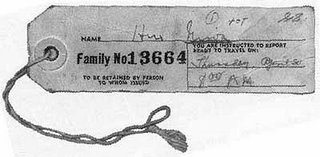Therefore, comprehensive immigration reform must include a better system for verifying documents and work eligibility. A key part of that system should be a new identification card for every legal foreign worker. This card should use biometric technology, such as digital fingerprints, to make it tamper-proof. A tamper-proof card would help us enforce the law, and leave employers with no excuse for violating it. And by making it harder for illegal immigrants to find work in our country, we would discourage people from crossing the border illegally in the first place.
Some suggestions for a "better system" and a "new identification card":

as worn by this lovely model on her way to the fabulous summer camp at Manzanar:

And of course, the Gold Standard for racial ID:

David Niewert adds much to the discussion of racism:
What's missing from this analysis is that, in fact, the Latino migration is occurring in many precincts that, historically, were all-white by design. As James Loewen details (excruciatingly) in his study Sundown Towns: A Hidden Dimension of American Racism, there are literally thousands of towns across America -- relatively few of them in the South -- who for much of the 20th century forbade minorities, blacks especially, from living within their communities. Many of them placed signs at the town limits warning "Whites Only After Dark" or "Nigger, Don't Let the Sun Set on You Here" -- that all nonwhites were to be out of town by sundown. In many cases, especially suburbs, no signs were visible, but all-white covenants provided the same effect.
Most of the "sundown towns" that Loewen documents were in the Midwest and West -- the same places where we're hearing complaints about a "Mexican invasion" now. The same places where George Bush sees his base eroding.
These same "sundown towns" have, unsurprisingly, a history of following racial election appeals, including broad support for George Wallace in 1968, and Republican presidential candidates in the ensuing years, all of whom made use of the Southern Strategy's core appeal to white racial interests:
- As a result of such leadership, Republicans have carried most sundown towns since 1968, sometimes achieving startling unaninimity. ... So the "southern strategy" turned out to be a "southern and sundown town strategy," especially in sundown suburbs. Macomb County, for example, the next county north of Detroit, voted overwhelmingly for Wallace in the 1972 Democratic primary. Wooed by Nixon, many of these voters then became "Reagan Democrats" and now are plain Republicans. The biggest single reason, according to housing attorney Alexander Polikoff, was anxiety about "blacks trapped in ghettos trying to penetrate white neighborhoods." [pp.372-373]
The core appeal of the Southern Strategy, as even the GOP admits now, was all about protecting white privilege, and so its reach ran well beyond the South.
The same is true of the newly emerging "Southwestern Strategy" -- and it is one that may similarly cut across regional and even party lines.
No comments:
Post a Comment